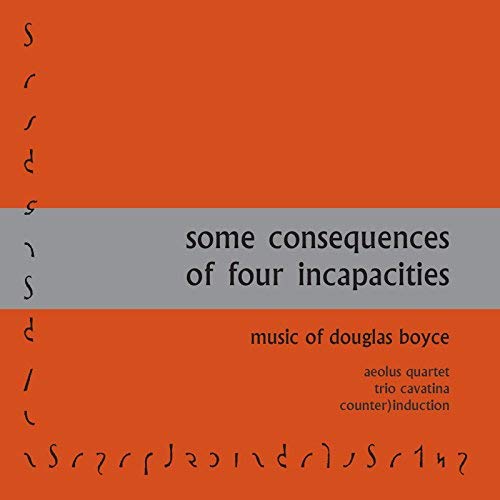
The rather plain cover belies the contents of this album of exciting and powerful chamber music. This is billed as a “sampler” album and it contains three works by Douglas Boyce (1970- ). He is a founding member, curator, and composer-in-residence of counter)induction, a composer/performer collective active in the New York region. He also has experience playing in various punk bands.
Boyce holds a B.A. in Physics and Music from Williams College, an M.M. from the University of Oregon and a Ph.D. from the University of Pennsylvania (1999). He has studied with George Crumb, James Primosch, Kathryn Alexander, Robert Kyr, Judith Weir, Ladislav Kubik and Robert Suderburg. He currently serves as Associate Professor of Music at the George Washington University in Washington, DC.
All this gives only the faintest hint of what his music sounds like. In the three works represented here the listener will notice some influence of Bartok and mid-century modernism. The first work “102nd and Amsterdam” (2005) reflects a composer well schooled in writing for string instruments. This piece is a string trio played by members of the Aeolus Quartet (Rachel Shapiro, violin; Greg Luce, viola; Alan Richardson, cello) and they are given a great deal to do. This is an energetic piece which engages the listener immediately and doesn’t really let go until the end some 14 plus minutes later.
The writing is virtuosic and the variety of techniques employed in his string writing are engaging and never seem gratuitous (i.e. extended techniques because I can). Despite multiple glissandi and other string effects the work, like the others on the album, are basically using the tonal language common to most western music. This is seriously engaging and masterfully developed music. It hooked this listener immediately.
The second work is Piano Quartet No. 1 (2009). This is an even more visceral work true to Bartokian esthetics. In its relatively brief 8 plus minutes the listener is taken on a virtuosic journey by the musicians of counter)induction (Jessica Meyer, viola; Sumire Kudo, cello; Steve Beck, piano) They are joined by the wonderful Miranda Cuckson who steps out of her soloist role and moves deftly into this chamber group as the finest musicians can do. Boyce cites influences as diverse as Robert Fripp and King Crimson but the details of that are not necessarily clear to this writer nor is it necessary to the appreciation of the work. It is a powerful and exciting piece of chamber music. This work left this listener a bit tired by the end (it is quite a workout) but the same ability to sustain interest and attention which applied to the first work is also present here.
Finally the Trio Cavatina (Harumi Rhodes, violin; Priscilla Lee, cello; leva Jokubaviciute, piano) presents a reading of the four movement “Fortuitous Variations” (2014). This most recent composition is the big work on this disc. The underpinnings, if you will, involve philosophical ideas and are elaborated well by the composer on his web site but, like the influences of the previous work, the music stands very well on it’s own.
There are four movements which seem to correspond (at least roughly) to the sonata form commonly used in such works. Each maintains it’s character as said variations are rolled out and, as in the previous works, sustains interest easily. This is perhaps a more ponderous work which is less direct than the previous two pieces but this most recent composition no doubt reflects the composer’s development and time will tell what direction his work will take. There is, however, a sense that the composer has developed a personal style and is cultivating it. Give a listen.
Most will want to hear these works multiple times. This reviewer managed to find three separate drives which allowed uninterrupted listening to the entire disc and I know those three won’t be the last.